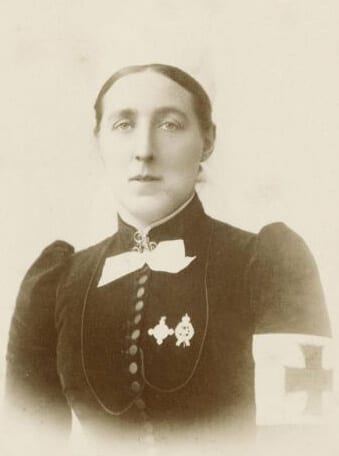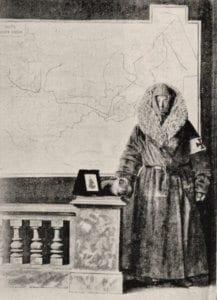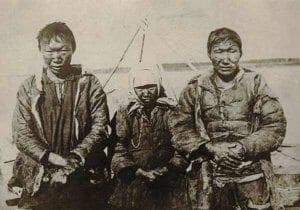Raisa Zubareva
Warsaw, Poland
 |
| Kate Marsden, photographed in 1892 before she set off for Sakha in Siberia to search for a herb said to cure leprosy. Photo by Otto Renard, Moscow. |
In humble circumstances in one of London’s asylums for the insane, Kate Marsden, a nurse and philanthropist who devoted her life to saving others, died on 29 May 1931. She had been the ministering angel of Siberians affected with leprosy.
Kate Marsden was born in May 1859, the youngest of seven children. Only Kate and her older brother survived; the others died of tuberculosis. At age sixteen she served as a Sister of Mercy in one of London’s hospitals. During the Russo-Turkish war of 1877-1878 she helped injured soldiers and saw patients affected with leprosy, also known as Hansen’s disease. At that time leprosy was still considered a dangerous malady, and affected patients were banished from society and even considered accursed. Kate was deeply moved by the agony of these sufferers and decided to pursue ways to help them.
She went to New Zealand after the war to take care of her last surviving sister. After her sister’s death she became a matron of the Wellington Hospital and also organized the Sisters of Mercy society under the mission of the Red Cross. Returning home from New Zealand, she went on a journey to North Africa and Asia Minor to learn more about leprosy.
During one trip to Constantinople, Marsden learned about a miraculous herb that could help treat leprosy and grew only in Siberia. She also found out that in the Vilyujsky District of the Republic of Sakha (Yakutia) there were large settlements of people with leprosy. She decided to take a great journey to search for these magical herbs. Marsden arrived in Saint Petersburg in November 1890. She had an audience with Empress Maria Alexandrovna, wife of Emperor Alexander II, who decided to help with everything she needed and provided reference letters. Leaving Saint Petersburg she traveled on a sledge and horseback under the Siberian frost through Samara and Irkutsk, receiving assistance from people along the way. In Irkutsk the governor helped set up the Committee for Lepers Aid.
The path from Irkutsk to Yakutsk ran through the Lena River and from Yakutsk to Obungda Lake in the Vilyuysky District, some 356 miles. Settlements of leprotic people were located in the lake regions. She rode on horseback, accompanied by a local priest and Cossacks. As the Yakut people learned about her mission they assisted by clearing roads and building bridges in the marshlands.
The next harsh challenge was to search for those suffering from leprosy, which meant traveling along all the neighboring lakes and riding deep into the heart of the forest. The problem was that the lepers lived in the forest far apart from each other. Nobody knew the exact location of each settlement, but in total the group found eighty leprosy sufferers.
Later Marsden recorded her experiences in the Yakutian Eparchial Journal published in 1892:1
 |
| Kate Marsden in full traveling dress. Published in on Sledge and Horseback to Outcast Siberian Lepers (1892). |
Dirt, sickening smell, glop from outer bark, fish, and butter, which people drink. In some settlements almost naked men, women and children lepers live side by side with domestic animals, they more seem to me as a beasts than human beings… Hearing their feeble and weak voices, seeing them praying, crossing and after hardly rising from knees, looking to their faces scarred by leprosy, reading in their eyes despond, finding loss of fingers on their hands and feet, so they drag own body only by help of stool, that look of lost hope – all that caused to us disruption, what we saw will remain in our memories till the end.
During her mission Mardsen saw small conical tents where people could hardly breathe and stayed together with animals. People slept on hard benches or on the floor in a sickening smell and blistering cold. In some tents the dead and living were found together. There was no medical care. On her return journey back to London through Saint Petersburg, Mardsen decided to organize a leprosarium in Yakutsk and started a fundraising campaign. She collected about twenty thousand rubles, enough to turn her idea into reality. The leprosarium had a church, a hospital with laboratory, and houses for sick patients. Two doctors were invited from Moscow, and a few Moscovian Sisters of Charity were appointed to Yakutsk. In London, Kate Marsden established the Fund for Lepers Aid and by June 1893, the fund had raised 2,400 British pounds, most of which was steered to the Vilyuysk leprosarium building. The leprosarium was opened in 1897 in Vilyuysk and functioned until 1963, giving aid to 252 leprosy sufferers.
In December 1893, Kate Marsden published a book named On Sledge and Horseback to the Outcast Siberian Lepers2 – both in New York and London. It was a great success and was reprinted twelve times within the first three years. Mention must be made of the miraculous herb that Marsden had heard about in Constantinople. She brought a sample of an herb named by locals as “strong herb” (in Sakha “күүстээх от”) and reported it to the Dermatological Association of England.3 She gave specimens of the herb to the Fund for Lepers Aid and sent to some to India to help the many leprosy sufferers there.
 |
| Leper yakuts in Viluisk (1905). |
Marsden faced personal challenges after her long trip. First the New Zealand press began to discredit her, followed later by Britain’s newspapers.4 She was accused of making false claims and misusing money. The charges were dismissed in a court of inquiry investigating the activities of the Fund for Lepers Aid, but it is noteworthy that Mardsen had a carefree attitude about money and lacked skills in money management. The press also published reports about “immoral behavior” including homosexuality and a tendency to aggression. She was forced to leave the Royal Geographical Society, give up the Fund for Lepers Aid5 that she had created and named for Saint Francis, and to renounce her own honors. Nonetheless she continued to serve with her earlier energy and strength. She inspired fundraising by the Bexhill Museum6 for Lepers Aid and retired as a trustee. In 1925, she was partially paralyzed by a stroke and died in 1930.
The people in Yakutia are still grateful to Kate, the Sister of Mercy. The Psychoneurological Institute in Vilyuysk is named after her, as was a 55-carat diamond found in Yakutia in 1991. The Ammosov North-Eastern Federal University (NEFU) founded the Mardsen Scholarship for English language studies. On March 29, 2014, a group of people from the Republic of Sakha (Yakutia) cooperated with British volunteers to restore Marsden’s grave in Hillington Park, London. The commemorative tablet contains words of gratitude from the people of Yakutia. That same year a monument was installed on the site of the former Vilyuysk leprosarium. She is remembered every year on January 30, World Leprosy Day, by the people of Yakutia and others around the world as a person with a big and kind heart.
References
- Путешествiе англiйской сестры милосердiя въ Якутскую область для помощи прокаженнымъ // Прибавленiя къ Церковнымъ вѣдомостямъ. — СПб.: Сѵнодальная Типографiя, 1892. — № 3 (от 18 января). — С. 79—85.
- Marsden, Kate. On Sledge and Horseback to the Outcast Siberian Lepers]. — New York: Cassell Publishing Company, 1892. — X, 244 p.
- The Nursing Record. — London: The Record Press, 1892. — Vol. IX, fasc. 239, no. от 27 октября. — P. 871
- Hapgood I. F. “Philantropy” on Horseback (англ.) // The Nation. — 1893. — Iss. 56 (1449). — No. from 6 April. — P. 258—259
- St. Francis Leprosy Guild
- Bexhill-on-Sea Museum
Bibliography
- Путешествiе миссъ Марсденъ въ Якутскую область и посѣщение ею прокаженныхъ. — М.: Типографiя общества распространения полезныхъ книгъ, Моховая, д. Терлецкой, 1892.
- Ефимов Ф. П. Загадочное и удивительное прошлое Якутии и якутов. Саха сирэ, сахалар таабырыннаах уонна кэрэхсэбиллээх былыргылара. — Якутск: Якутское республиканское общество «Книга», 1994. — 384 с.
- Middleton, Dorothy. Victorian Lady Travellers. — London: Routledge & Kegan Paul Ltd., 1965. — P. 128—145. — 182 p.
RAISA ZUBAREVA studied at the Ammosov North-Eastern Federal University in the Republic of Sakha (Yakutia), Russia. She worked for over ten years as a journalist for the Yakutsk Evening newspaper and currently lives in Warsaw, Poland.
Highlighted in Frontispiece Volume 11, Issue 2– Spring 2019
Winter 2018 | Sections | Infectious Diseases

Leave a Reply